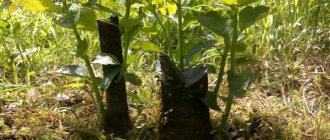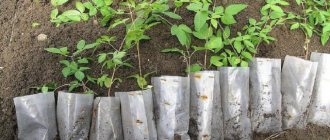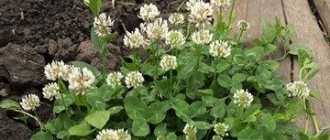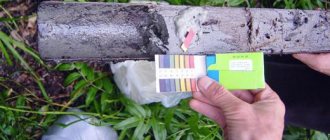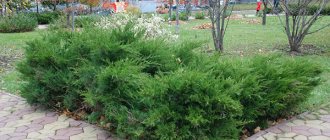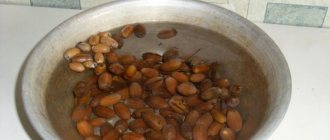How to remove grass from paving slabs
Manual method
Heavily overgrown grass in the joints of paving stones can be removed manually, if possible, by tearing it out along with the roots.
Pros:
- inexpensive;
- environmentally friendly;
- helps against mature weeds.
Minuses:
- short-term effect;
- seeds may remain inside.
For work, it is convenient to use special L-shaped garden knives for cutting weeds (Fiskars, Wolf-Garten, etc.). This type of equipment is also sometimes called a “root remover” or “crevice cleaner”; it will help you reach grass even in the most difficult to reach places.
If you don’t have special equipment, you can use a thin spatula or a mounting knife to remove the grass.
It is advisable to remove weeds manually before the seeds ripen, and also to combine weeding with subsequent treatment with water or special liquids.
Pressure flushing
Using a pressure washer or high-pressure pump can wash the grass seed out of the joints. In addition, washing will also clean the tiles from dirt and dust.
Pros:
- effective against seeds;
- harmless to paving stones;
- the sidewalk is additionally cleared of dirt.
Minuses:
- helps in the short term;
- rising costs, special equipment required.
For these purposes, it is convenient to use a garden washer with a set of nozzles of different diameters, in particular, equipment from Karcher, Grunhelm, Intertool, Bosch, Stihl, Nilfisk, Makita, Sturm and etc. They operate under a pressure of 20-140 bar, with an average water flow of 250-500 l/hour, and are connected to a regular 220 V power supply.
It is necessary to ensure that the grout is not washed out too much from the seams; if necessary, sand or grout can be added after work.
Heat treatment
Another good option is to pour boiling water over the joints 1-3 times, directly from the kettle.
Pros:
- the cheapest and most accessible way;
- affects both seeds and mature grass;
- harmless to tiles (if it is water and not fire).
Minuses:
- scalding often has to be repeated;
- does not always help against the most harmful weeds.
It is worth considering that the var may not give results the first time. For the best effect, it is appropriate to use boiling water, where eggs were boiled, or a hot soda solution (from 3-4 tbsp. L/liter).
But a burner for heat treatment is not recommended: despite its high efficiency, burning can severely damage the garden path.
Chemical treatment
This is the most effective option, “chemistry” kills weeds with a guarantee, although the method is quite harmful. It is convenient to use a spray bottle to apply medications.
Pros.
- completely destroys both weeds and seeds;
- This is basically a low cost method.
Minuses.
- can sometimes harm paving stones;
- affects neighboring crops.
Let's look at some methods of chemical exposure to grass in tiles
Ammonium nitrate. You can spray overgrown joints with a 10-12% solution of ammonium nitrate (1-1.2 kg/bucket). After 4-5 days, it is recommended to repeat this procedure.
Herbicides. Continuous herbicides are ideal against grass, primarily Roundup and its various analogues, as well as Tornado, Agrokiller, Hurricane Forte, Astera, Chistopol, Dialen Super, Lontrel ", etc. Herbicides should be used strictly according to the instructions, at above-zero temperatures and in dry weather. Their only drawback is the price.
Borax. Dilute 300-350 grams of borax (sodium tetraborate) in 10 liters of water, then mix and spray on the weeds. By the way, borax also helps against ants.
Salt. A solution of table or potassium salt (15-20%) also removes grass well. True, if “pure” salt is used, it should be used in moderation - its excess can harm the tiles, especially concrete ones.
Vinegar (various options):
- at 3.7-4.0 l. 9% table vinegar, take half a glass of salt (100-110 g) and a teaspoon of liquid detergent;
- 4-5 glasses of table vinegar are diluted in 2 liters. water;
- to 2 glasses of vinegar add 3 tablespoons of lemon juice, 30-40 g of alcohol and 2 tsp. detergent, then dilute the composition in water 1 to 1.
Important! Any chemicals are an aggressive environment that can “burn out” nearby house plants - lawns, flowers near the borders, or pollute an artificial pond.
It is optimal to use the preparations in places where there are no cultivated plantings, and also apply them very carefully, not forgetting about personal protective equipment. In addition, the reagents should not destroy the tiles or leave stains: before treatment, it is appropriate to test their effect on a small fragment of the path in an inconspicuous place.
Combination of methods
For greater efficiency, different methods are often combined. For example, you can first remove mature weeds by hand, then thoroughly rinse the tiles with a sink or hose, and then apply a special preparation or pour boiling water over the joints.
Preventive actions
- Any body of water located near a garden plot contributes to gradual waterlogging of the soil, which is why in the spring it is recommended to make small grooves to drain excess moisture from the soil.
- Do not forget about the annual application of fertilizers to the beds for the full development of cultivated plants, which will significantly reduce the activity of moss.
- Regularly prune bushes and trees to avoid shading the area; in a sunny and well-groomed area, mossy thickets quickly die. It is recommended to sprinkle garden paths with small pebbles or wood chips.
- When planting vegetables in a greenhouse, do not forget about the need to ventilate and loosen the soil. Lack of fresh air, excessive humidity and lack of fertilizers provoke the development of the parasite.
- You can prevent the appearance of islands of moss on the roof of buildings by installing copper roll materials, however, they rarely go on sale.
- In this case, moss activity can be reduced by regularly removing leaves from the roof, as well as by cleaning the roof annually.
Also read: Rules for growing watermelons and melons in a greenhouse
Mossy thickets should be cleaned using special brushes and gloves, collecting plant debris in buckets or containers
How to remove moss from a garden path
First of all, you need to clean the path as much as possible from lichen mechanically (wet sand, brush, attachment to an angle grinder, etc.), then thoroughly rinse the tiles with a sink or hose, and then treat the surface with one of the following products:
- 10% solution of copper sulfate;
- solution of laundry soap (approximately 200-300 g/bucket);
- ordinary aqueous solution of table vinegar (1:1);
- a mixture of boric acid and borax (1:1);
- a store-bought moss remover such as Anti Mousses Guard or Medera Anti-Mold.
After exposure, the remaining drug is washed off.
How to prevent weeds and moss
Rainwater gets into the joints of the paving stones, goes inside and begins not only to wash away the sand, but also washes it inside the crushed stone. As a result, the tiles sag, the gaps widen and weeds become active.
And moss usually appears due to improper drainage and damp sand, especially in shaded or clayey areas. Mold also “loves” areas where soil and organic matter get into the substrate and seams.
Therefore, it is important to follow the tile laying technology.
In particular, the “pie” of paving stones must have a load-bearing drainage layer of compressed crushed stone of the required thickness depending on the load.
In addition, it is recommended to lay geotextiles at the bottom of the trench under the foundation and/or under the mounting pad, already on top of the crushed stone. Geofabric protects against weeds, prevents soil erosion, minimizes soil shrinkage, reinforces the path, accelerates water drainage and prevents backfill layers from mixing. Geotextiles are especially recommended for heaving or clayey soils. In this case, it is advisable to throw the membrane on the walls of the trench in order to minimize contact with fertile soil.
As for the cushion on which the tiles are laid, with regard to weeds, prancing (sand-cement mixture) is preferable: in this case, weeds and moss do not come out as actively. In addition, the beading strengthens the structure, “binds” the sand, and also minimizes the washing out of the cushion and the saturation of the joints with moisture.
Tips for caring for paving slabs
Any crack in the sidewalk increases the risk of mold and weeds, so you should take proper care of your paving stones.
- You cannot drive a car on the tiles if it is not designed for this.
- Avoid dropping heavy objects on the path.
- You need to sweep the tiles regularly, but only with a broom or a “soft” plastic brush to avoid scratches, and contaminated areas can be washed with water from a hose or sink.
- It is necessary to promptly identify and remove any suspicious stains on paving stones.
- The seams should be refilled occasionally.
- Any chemical treatment should not cause crumbling or deformation of the tiles.
- You should fight anthills (vinegar, borax, special preparations, etc.).
- If desired, the paving stones can be treated with a water-repellent agent - this will reduce the risk of water penetration and destruction of the top layer of coating.
- In winter, the tiles should be cleared of snow, but only with a wooden or plastic shovel.
Thanks to such measures, you can prevent the appearance of weeds and moss on the paving stones or remove them in a timely manner. As a result, the service life of the coating will be significantly extended, and the garden path paved with tiles will always remain very pretty and clean!
We'll tell you and teach you
It is unlikely that anyone will be happy with the appearance of moss on paving slabs and other concrete surfaces. How to quickly and effectively get rid of green growths that have appeared?
Where does moss come from?
Most often, moss appears in areas with high humidity, especially on the north side.
Moss spores carried by the wind, once in a favorable environment, take root and begin to rapidly multiply.
In a matter of weeks, paving slabs or the wall of a house become covered with an unsightly layer of moss. These plants perfectly absorb and retain moisture, so the surface of the concrete under a layer of moss will always be damp.
Excess moisture over time will inevitably lead to its cracking and destruction, and therefore mossy vegetation must be gotten rid of as soon as possible
Mechanical moss removal
Armed with a spatula, scraper, metal or plastic brush, begin to carefully and methodically remove the green islands of unwanted vegetation.
Having cleared the surface area of moss, rinse it thoroughly with water and meticulously evaluate the results of your work.
Even microscopic remains of a moss colony remaining on the concrete surface must be removed by repeated cleaning, otherwise the surviving moss spores will grow again, turning the surface of the paving slabs into a soft green carpet.
Using a high-pressure washing machine greatly simplifies the process of getting rid of moss. In this case, you can completely get by with water alone without the use of chemicals and detergents.
Use of household chemicals
Mechanical cleaning does not always give the desired results, so to ensure that unwanted vegetation is removed, it makes sense to use chemicals.
The oldest and most proven moss remover is copper sulfate.
Treat the problem area with a solution of copper sulfate (500 g / 10 l of water). The product will saturate the unwanted plant layer right down to the roots, destroying its viability.
If there is a thick layer of moss, it may need to be re-treated with a solution.
After a week or two, the plants will turn yellow, die and dry out. All that remains is to sweep them off the concrete surface with a brush or wash off with a stream of water.
In addition to copper sulfate, chlorine-containing liquids, for example, bleach for washing fabrics, will help deal with moss colonies.
Dilute 1.5-2 liters of bleach in 10 liters of water. The procedure for using it is the same as for copper sulfate.
You can prepare a moss remover yourself by mixing equal amounts of vinegar and water.
In the end, you can generously and repeatedly pour boiling water over the problem surface. The effect will be no worse.
To avoid the reappearance of moss, remove nearby tree branches and bushes if possible.
By improving air circulation and opening access to sunlight, you will not leave mossy vegetation a single chance.
Good luck to you! May everything work out for you!
How to get rid of moss in a garden plot: effective methods of control and prevention
Pressure cleaning. Use a pressure washer to thoroughly clean the work area. Use a high pressure washer without using any chemical solutions or soap, this solution will already remove some of the moss quite quickly. This solution will also help you blur the seams between the pavers, giving the moss no place to hide. Environmental change. You should understand that moss grows best in moist and shady areas, and if possible, you can change its habitat as a solution.
To reduce humidity and shade, you can remove nearby bushes or tree branches if possible, and you should also remove anything that holds moisture, such as dead leaves. Use of chemicals. There are a number of different chemicals that can be used to remove moss, including household bleach, which has a high chlorine content.
Remember, some of the products listed will also kill other plants, so you need to work accurately and carefully to remove only the moss and not affect your garden.
Please read the instructions and follow them carefully for best results. Tips and warnings. Apart from directly using your own pressure washer, you also have a number of viable options. When deciding to build a road surface, already at the stage of laying the base layers it is necessary to ensure that there is sufficient drainage.
We'll tell you and teach you
It is also important to lay the paving stones themselves correctly so that water does not collect in uneven areas. When pavers are laid on an unacceptable clay base, the installer must provide additional drainage. Garden paths and driveways should be constructed in such a way that rainwater can pass through them without any obstruction or delay.
Special drains and well-prepared soil help prevent paving stones from becoming overgrown with moss, even in shaded areas. Protecting paving stones from the appearance of moss also means removing fallen leaves from its surface. This simple procedure helps protect against the accumulation of unwanted excess moisture on the surface of the coating.
Green stains and moss can be effectively removed mechanically. The tools used must be equipped with hard rubber protection so as not to scratch the surface of the coating.
Paving stones can also be cleaned using a strong stream of water. High pressure washers are ideal for this. Chemical methods can also be used.
There are moss removal products on the market. The surface should be treated with an appropriate product and wait, and then rinse with water.
Please tell me how to get rid of moss and mold on paving slabs? Is it possible to do without expensive funds?
Manufacturers often recommend repeating this operation. It is better to treat the road surface early in the morning or in the evening to reduce the intensity of evaporation of the drug; in general, cleaning of this kind must be carried out at above-zero temperatures. Paving slabs laid near a pond should be treated with extreme care and attention so that the drug does not get into the water, since it is toxic to underwater inhabitants.
When using moss removal products, you must follow all precautions recommended by the manufacturer. To begin, conduct a thorough check of the condition of the paving stones' texture, identifying any tiles that contain cracks or chipped edges.
We hope that when installing the paving stones, you took care of stocking up on additional tiles in case of repairs. Damaged paving stones must be replaced.
If the paving stones were laid using glue or polymer sand, removal will be a little difficult, however, nothing is impossible in the world. Carefully, using a hammer or chisel, remove the unusable paving slabs and replace them with new ones.
Then we move on to weeding. Carefully remove all grass and weeds that destroy the overall appearance and strength of the paving stones, gradually growing through the seams of the paving stones. Clean the sidewalk thoroughly, removing leaves, dust, and other debris. Be sure to use weed control netting at the base of the pavers.
It is advisable to use dishwashing detergent, warm water, and a stiff brush to thoroughly clean the paving slabs from stains that contaminate them.
If your pavers are stained with more difficult stains, such as rust stains, then you will most likely need complex chemicals. Be very careful when selecting the cleaning product. The large number of traditional chemicals we use in our homes may well harm the integrity of the paving stone structure. It all depends on the material of the paving slabs. In the case when hot water, detergents, and a stiff brush do not help remove stains, in this case it is better to go to a hardware store and ask the seller to select a product intended for this paving stone material.
To avoid rust stains in the future, make sure that the legs of your iron furniture or grill are treated with a rust-inhibiting product. If, when examining the exterior paving tiles, you find stains of paint, you can use a solvent.
Gently apply the solvent to the paint stain, then let it work on its own for ten to fifteen minutes, then scrub the stain thoroughly.
We'll tell you and teach you
It is unlikely that anyone will be happy with the appearance of moss on paving slabs and other concrete surfaces. How to quickly and effectively get rid of green growths that have appeared?
Where does moss come from?
Most often, moss appears in areas with high humidity, especially on the north side.
Moss spores carried by the wind, once in a favorable environment, take root and begin to rapidly multiply.
In a matter of weeks, paving slabs or the wall of a house become covered with an unsightly layer of moss. These plants perfectly absorb and retain moisture, so the surface of the concrete under a layer of moss will always be damp.
Excess moisture over time will inevitably lead to its cracking and destruction, and therefore mossy vegetation must be gotten rid of as soon as possible
Mechanical moss removal
Armed with a spatula, scraper, metal or plastic brush, begin to carefully and methodically remove the green islands of unwanted vegetation.
Having cleared the surface area of moss, rinse it thoroughly with water and meticulously evaluate the results of your work.
Even microscopic remains of a moss colony remaining on the concrete surface must be removed by repeated cleaning, otherwise the surviving moss spores will grow again, turning the surface of the paving slabs into a soft green carpet.
Using a high-pressure washing machine greatly simplifies the process of getting rid of moss. In this case, you can completely get by with water alone without the use of chemicals and detergents.
Use of household chemicals
Mechanical cleaning does not always give the desired results, so to ensure that unwanted vegetation is removed, it makes sense to use chemicals.
The oldest and most proven moss remover is copper sulfate.
Treat the problem area with a solution of copper sulfate (500 g / 10 l of water). The product will saturate the unwanted plant layer right down to the roots, destroying its viability.
If there is a thick layer of moss, it may need to be re-treated with a solution.
After a week or two, the plants will turn yellow, die and dry out. All that remains is to sweep them off the concrete surface with a brush or wash off with a stream of water.
Video instruction: how to get rid of mosses and lichens
If you notice moss on the roof, in the cracks between the tiles of the garden paths, in the paving stones or on the fence, then this is a bad sign. Unless you want your home and garden to become overgrown with moss, then you will have to think about how to eliminate it. DELFI Tava Māja has collected folk methods of moss control and practical recommendations from users of the Cālis magazine forum.
First of all, it is important to understand under what conditions moss appears. And it, like many lichens and algae, grows in a humid environment, which means that the surface underneath is constantly wet, so it can become damaged. For example, concrete will crumble, metal will rust, and wood will become rotten.
As experts point out, moss forms most actively on the northern part of the roof, where there is the least sun. In turn, forum activists said that the reason for the appearance of moss on the roof may be ventilation and insulation of the house. Under the layer of moss, a microclimate is formed that destroys any coating, even metal. So, the moss must definitely be removed. Roof cleaning can be done manually or using biocides. The easiest way is to use a strong stream of water (like when washing a car). But it is important to ensure that the coating itself is not damaged as a result. It is best to add car shampoo or other detergent to the water. The roof should be washed from top to bottom. Read more about eliminating moss on your roof here.
On store shelves you can find a special product for eliminating moss, lichens and algae from various surfaces. But forum activists have repeatedly noted that chemicals are not the best way to get rid of moss. In their opinion, mechanical cleaning is much more effective, and then chemicals can be used for preventive purposes. If there is very little moss, then the product can help, but to eliminate a thick layer of moss, the treatment process will have to be repeated many times.
As for mechanical cleaning, in this case the moss is scraped off with some kind of tool, but this does not always solve the situation. Roots and spores of moss still remain on the surface, which can recover after some time, so it is worth additionally using a chemical agent and repeating mechanical cleaning periodically. The moss scraping method is not suitable for painted metal and stone chips, and in such cases the surface must be washed from top to bottom.
Another alternative is to clean the surface with a high pressure jet. But keep in mind that in this way you can damage the roof covering, for example, scratch the concrete, knock out some stone or loosen the tiles. This method can be entrusted to specialists, or you can try it yourself, but first it is recommended to try other methods of mechanical or chemical cleaning.
Those who have experience in cleaning moss from surfaces know that the sooner you start acting, the better. When the first signs of unwanted moss appear, you must hurry to eliminate it, and, of course, you should not wait until the moss becomes thick and only then act. Time in this case works against you.
Is it necessary to fight moss?
Many gardeners believe that moss only causes aesthetic damage, but in fact it can destroy plantings on a plot or in a greenhouse in a short time. It is a parasitic plant that reproduces very quickly, and during the growth process actively consumes carbon dioxide, liquid and nutrients. Moss disrupts gas exchange, increases soil acidity and contributes to waterlogging of the site, as a result of which useful crops suffer and the quantity and quality of the harvest decreases.
However, sometimes mossy cover can be beneficial. Some garden and garden plants require high acidity, and in order to achieve the required levels, owners of plots with slightly acidic or neutral soils purposefully plant moss. The plant has a bactericidal effect, destroys pathogenic microorganisms and fungal spores, and therefore can be used as a protective agent. And yet, in most cases, moss is considered a parasite that has a detrimental effect on crops grown in open ground or in a greenhouse.
Why does moss appear?
Before starting the fight against mossy cover, it is necessary to determine the cause of its appearance and, if possible, eliminate it.
The appearance of the parasite is provoked by the following factors:
- The soil on the site is too wet, groundwater stagnation.
- Permanent shading of beds or lawns.
- Increased soil acidity.
- Lack or excess of nutrients.
- Incorrect selection of fertilizers and plant care.
To correctly determine the cause of the appearance of moss, you need to pay attention to its features. In acidic soil, long plants with straight shoots appear, which are greenish on top and brownish at the base. On waterlogged soils, gray-green moss grows, which spreads over the surface of the area, and on overmown grass it spreads like a continuous mat.
In addition, moss often appears on the walls and roofs of outbuildings and paths, including asphalt ones. Most often this happens after microcracks and damage appear on the material, in which excess moisture accumulates.
How to deal with moss
Controlling green cover is a lengthy process that can take weeks or even months. You can destroy it in several ways, and it is best to use them in combination, and be sure to influence the cause of the appearance of moss.
Soil deoxidation
The parasite feels best on acidic soils, so the soil needs to be deoxidized. To do this, you need to add fluffed lime (50 kg per 100 sq.m.), dolomite flour or wood ash. To prevent the appearance of moss in the future, the procedure will have to be carried out every year.
Reducing humidity
If the soil in the area is too wet, it is necessary to loosen it, make drainage grooves if necessary, and add sand and humus to improve the structure. Plantings or lawns should be watered sparingly and only during the daytime or in the morning, and in early spring or late autumn, watering should be kept to a minimum.
Eliminating excess shadow
Moss does not like sunlight, so excess shadow needs to be removed wherever possible - cutting off spreading tree branches, dismantling mountains of garbage and old things.
In places where it is impossible to increase the illumination, it is recommended to plant shade-loving plants - ferns, hydrangea, astilbe, hosta, etc. Over time, they will grow and “displace” the moss from the beloved area.
Weed control
Tall weeds like nettle and quinoa create favorable conditions for the appearance of moss, so you need to get rid of them as soon as possible.
Fertilizing
To improve soil quality, combat mosses, fungal spores and pathogenic microorganisms, fertilizers with a high content of potassium, iron and nitrogen are used. When applying nutrient mixtures, you must strictly follow the instructions - an excess of fertilizers harms the soil no less than their lack.
Mulching
Beds and lawns can be mulched with pine needles, straw, sawdust or tree bark to prevent moss from spreading. Since the plant loves lowlands and depressions most of all, it is better to grow vegetable crops in small elevations.
Mechanical removal
Moss on asphalt, tiles and building surfaces can be removed mechanically - cleaned with a soft brush and soap solution.
Before you start fighting moss, you need to carefully collect all the plants from the surface where they have spread. They do not have deep roots, so it is enough to collect the green “carpet” with a rake and take it as far away from the site as possible, or better yet, destroy it.
Chemicals
You can fight moss in your garden using chemicals designed to destroy parasitic plants:
- Mossy cover that covers tiles, asphalt or walls can be destroyed using herbicides based on glyphosate - Roundup, Lintur. They need to treat the surfaces as indicated in the instructions, and then collect the blackened plants with a rake.
- The most effective means for destroying the parasite are ammonium, copper, and ferrous sulfate. To prepare a working solution, you need to dilute 100 ml of the substance in 20 liters of water and spray it in places where moss grows.
- On lawns, you can get rid of the uninvited resident using dichlorophen. They need to water the lawn, and after the cover turns black, collect it and sow the free space with grass.
- A safe, but less effective remedy for combating moss is a solution of soda with soap or dishwashing detergent. For 2 liters of water, you need to take 200 g of baking soda, add grated soap or dish soap, and then spray the solution on the infected areas.
Potent remedy
If you don’t visit your garden very often and you don’t have time for manual cleaning, there is another method for how even an inexperienced, novice summer resident can get rid of moss in a garden plot. Potash is diluted in a bucket in the usual way, but with the addition of 150 grams of carbolic acid. If there is no potash, five kilos of wood ash are poured with ten liters of water for two days - and you get the desired liquid. The areas affected by moss are generously treated with a warm solution - and after a couple of days it dies and falls off. If you are not lazy and whiten the trunks in the spring, you are guaranteed against new weed plantations for five years.
How to deal with moss in a greenhouse
Moss appears in a greenhouse for the same reasons as in a summer cottage. You need to start getting rid of it as soon as possible, otherwise the parasite will quickly spread and suppress the growth of vegetable crops.
First of all, you need to organize normal air exchange in the greenhouse, and make depressions in the soil using a fork so that the air penetrates into all layers of the soil. They should be deep enough, with an interval of at least 10-15 cm.
If the cover has grown greatly, about 30 cm of the soil surface should be removed, and the end parts of the greenhouse should be washed with water and laundry soap. In place of the removed soil, it is necessary to add fresh soil, and it must be taken from sunny areas.
After this, you need to check the soil for moisture and acidity levels, and then improve its quality (add sand or lime). Before planting plants, the soil needs to be fertilized - add mixtures containing potassium, phosphorus, nitrogen, but do not overdo it, otherwise the moss will grow even more intensively.
In the future, to prevent the appearance of moss, it is necessary to maintain normal air exchange and humidity levels in the room.
How to get rid of moss
On a summer cottage, green islands appear in the following places:
- greenhouse;
- lawns and beds;
- garden paths;
- roof of the building.
First of all, it is necessary to remove the parasite thickets from the greenhouse. This process should not be delayed, since moss islands in the greenhouse negatively affect the condition of the crops growing in it.
- First, ventilate the room by opening all the windows and doors.
- Then you should make depressions in the soil using rods: this way the air will better penetrate into the deep layers of the soil. Holes in the ground will help cultivated plants get enough moisture and oxygen.
- Next, the soil must be thoroughly cleaned of moss.
- Acidic soil should be supplemented with quicklime and sand or dolomite flour should be scattered on the beds.
Also read: Weigela: rules for autumn care and preparation for winter
In order to get rid of moss in a greenhouse, it is necessary to ventilate the room by opening all the windows and doors.
It is important to know that mossy thickets significantly deplete the soil, which means that cultivated plants need additional feeding depending on the type and variety.
Dealing with moss in beds is much more difficult , because in most cases it appears here due to waterlogging of the soil. At risk are dacha plots located near rivers and swamps, as well as in lowlands. It is not difficult to determine the level of soil moisture - you just need to take a handful of soil in your hand and pay attention to its properties.
You can also remove moss by saturating the soil with slaked lime, which is added during the process of digging up the garden annually.
In order to reduce the number of mossy thickets in the area, it is necessary to make small grooves around the perimeter of the garden plot. In addition, the parasitic plant loves uneven areas and depressions in the garden. In this case, the ground should be further leveled by adding sand to improve drainage. Moss can also be removed by saturating the soil with slaked lime, which is added during the process of digging up the garden annually.
Why do mossy thickets affect lawns? Here the parasitic plant is activated due to the shade of the area, in addition, too short grass is most susceptible to damage by mosses. In this case, you should increase the illumination or sow this part of the territory with grasses such as meadow grass or fescue. These crops are resistant to shading and are less likely to be affected by parasites.
The ground should be further leveled by adding sand to improve drainage.
As a rule, the rapid development of moss occurs in spring and autumn , so during these periods it is recommended to use chemicals to radically combat the parasitic plant. To prepare the solution you will need 100 ml of any sulfate - copper, ammonium or iron. The active substance should be diluted in 20 liters of water and mixed well. The mixture is sprayed evenly over the entire area no more than once a year.
Some gardeners successfully use Dichlorophene, a herbicide that allows you to quickly get rid of mossy thickets in your garden.
It is best to plan treatment for the autumn period; after the procedure, you should cover the ground with mulch.
Also read: Features of making a greenhouse with your own hands
Tips and secrets
- Do not destroy moss in greenhouses or beds using a solution of copper sulfate. It will destroy beneficial plants and microorganisms that live in the soil and significantly reduce its fertility.
- To prevent the growth of the parasite on the lawn, you need to mow the grass regularly, and the mowing height should be no more than 6 cm.
- Favorable conditions for moss growth are not only waterlogging of the soil, but also insufficient moisture. Grass and useful plants become weak during prolonged drought, and after the first heavy watering or rain, a green cover will immediately appear on the soil surface.
- During the season, it is recommended to sprinkle wood ash under the roots of plants. It is an excellent fertilizer and also destroys spores that cause moss growth.
- In areas of the lawn cleared of moss, it is better to sow bentgrass, fescue or bluegrass.
- Before planting vegetable and garden crops, you can sow the soil with green manure - oats, mustard, lupine. They saturate the soil with oxygen and nutrients, which prevents the development of parasitic plants.
- When digging up an area in the fall and spring, you should try to level the area as much as possible, since moss grows best in holes, depressions and depressions.
- Houseplant lovers can use moss to improve the health of flowers. An infusion is prepared from it, which is used to destroy fungi and pathogenic microorganisms, and it is also convenient to grow violets, orchids and other crops that require high soil acidity on a mossy “carpet”.
Getting rid of moss is not an easy task, since this parasite is amazingly resilient. It can only be solved by using an integrated approach, but in the future the owner of the site will need to maintain optimal soil condition, otherwise the unpleasant green carpet will appear again.
How to get rid of moss: good advice and the most effective methods
Rinse the tiles thoroughly after removing the paint. Let your pavers dry completely. Do not allow the sidewalk to be used until the pavers are completely dry. Don't forget to clean your tiles regularly, too. Constantly monitor the grass and weeds, we recommend timely weeding. Replace damaged paving slabs in a timely manner; this will help maintain the sidewalk in an attractive, perfect form for a long time and increase its service life.
Using a high pressure water washer will certainly make the job much easier, but this approach is not recommended for cleaning pavers.
Reasons for the appearance of moss in the garden plot
Strong water pressure can cause significant damage. If your sidewalk is made of clinker pavers, never use acid-based cleaners as they can ruin the pavers. Real paving stones require special care.
Don't forget about safety precautions. Protect your eyes, respiratory tract and skin when working with chemical cleaning agents. The roof of a house located near bodies of water or in the shade of trees is more likely to be covered with a yellowish-green, brown or gray coating years after construction - this will mean that spores of moss and algae have already begun to multiply in order to subsequently form moss, which brings a lot of damage. troubles for the owners of the house.
It usually forms on the rough, soft surface of the tiles; the spores simply roll off on a smooth surface or at the joints of the roofing material.
Spores from moss and lichen usually fall onto the roof either with the help of the wind carrying them from the trees, or with the help of birds carrying them on themselves. In any case, even if your home is located away from trees, moss can still affect the roof. Its spores begin to grow vigorously in that part of the roof where the sun hardly reaches, and there is a tendency for liquid to accumulate from dew, snow, rain, and there is also a nutrient medium in the form of dirt, dust or accumulation of leaves.
These are materials with a porous and rough surface, sometimes soft, prone to water absorption, and therefore serving as an excellent area for the development of various organics. Such materials include various types of tiles: soft, flexible, clay, ceramic, composite, cement-sand, metal tiles, as well as slate and asbestos-cement sheets.
It is worth remembering that a steep roof with a smooth surface has fewer prerequisites for moss spores to take root.
Vegetation forms on those areas of the roof that are in the shade for most of the daylight hours, or where it is most humid.
When they talk about moss on the roof, they usually mean that it spoils the appearance of the northern, northwestern and, less often, western sides, while the southern and eastern parts remain unaffected by this problem; in general, the sun, which is above these parts for most of the daylight hours, dries and does not allow it to grow.
In addition, the presence of a tree or other building next to the roof darkens a certain area of the roof, which means that dew or residual rainwater or snow takes longer to dry, creating a favorable environment for organic matter, in particular for moss. There are fans of a moss-covered roof who believe that this gives the house a special flavor and mystery, however, usually the vegetation on the roof still does not suit the owners, and they believe that this way the house does not look very aesthetically pleasing, while it resembles an abandoned one, this is especially noticeable on roof made of flexible, soft tiles.
This is probably the main reason why many owners of manor houses are beginning to make sure that their roofs are free from moss and plaque. Let's look at more significant reasons why you should be concerned about eliminating vegetation on your roof:. To get rid of problems associated with the appearance of vegetation on the roof, it is worth taking measures during construction that will prevent the growth of unwanted plants.
At the moment, American and Canadian companies involved in the production of soft roofing are developing materials that will contain a bitumen product designed to protect the roof from the appearance of vegetation on it. However, this method has already identified significant drawbacks, the main of which is that after 2, maximum 3 years, the protective layer ceases to be suitable, i.e.
In Europe, it is customary to get rid of moss by installing copper roll materials on the roof, which are a mesh-shaped tape with a width of 50 to mm, which has a self-adhesive layer on the back side. With its help, the tape is mounted, namely, rolled out and strengthened under the ridge element. Thus, rainwater and copper ions react to form an antiseptic solution that flows down the cavity of the slope and prevents the growth of moss.
This product also helps get rid of black spots that occur due to the development of blue-green algae. In Russia, this type of protection against moss is not popular, because
Often, the nets are made on site, along with the installation of copper parts that prevent the growth of moss. For this type, many also use copper wire, which is wrapped around the invisible part of the ventilated ridge.
This mesh can also serve as excellent protection against insects. Also, at the stage of building a house, it would be useful to install copper components to the roof in the form of eaves and wind strips, junctions, etc. If your roof is ceramic or metal, it is necessary to install copper valley strips.
For preventive purposes, the roof must be inspected at least twice a year, and do not forget to regularly monitor the condition of the drainage system. Carefully sweep away leaves, debris and other dirt, being careful not to damage the protective layer itself.
Roofing materials must be impregnated with various compounds that increase biostability. When planning work to get rid of moss on the roof, you need to choose the right day. It is best to carry out such activities in the fall, in cool weather, when it will be drier and easier to remove from the surface.
It is necessary to clearly divide the scope of work, and also not to forget that you will need tools, gloves and a brush. Upon completion of the work, it is necessary to collect everything in a specially designated container in order to avoid its re-growth, including on other surfaces. The cleaned roof is usually treated with a chlorine solution, 2 liters of bleach diluted in a bucket of water over the entire surface.
Moss and lichen are destroyed in several ways. One of them is to treat the affected part of the roof with a solution of water and chlorine bleach, prepared in proportion. This method is usually offered by manufacturers of flexible tiles.
The solution must be applied to the roof surface with a sponge, moving from the ridge to the eaves overhang. If it is difficult to remove particularly large growths from moss, you must use a soft brush, but do not forget that you need to use it with caution, without using force, so as not to damage the roof.
At the end of the work, the remaining solution is collected in a specially prepared container so that it does not harm the plants in the area around the house. It is also necessary to take into account that the work is carried out at temperatures above zero degrees, on a day without wind, in order to avoid loss of the necessary properties of the reagent. The mechanical method of roof cleaning, in which moss is removed either manually or with water, also continues to be popular. This is done manually in two ways: with a stiff metal brush or with a power tool.
In the first case, the moss is simply scraped off from the roofing surface, in the second, it is removed with a power tool, which is often an ordinary drill with an attachment.
It is worth noting the complexity and labor-intensiveness of the process, as well as the fact that not every roofing material can be cleaned in this way without damaging its surface. For example, when cleaning flexible tiles, there is a risk of damage, you can accidentally scrape off their protective layer, and when removing moss by hand from asbestos-cement slate sheets, there is a possibility of inhaling toxic dust. Another common mechanical way to rid a roof of moss is to use mini-washers, high-pressure machines that clean the roof with a powerful jet of water.
This is quite painstaking work, in which you need to sequentially process the roofing surface, starting with the ridge and ending with the eaves overhang. To consolidate the result, it is advisable to treat the roof with a protective compound. This method is quite effective and simple, but we must not forget about the danger of damage to the roof, i.e. You cannot treat the roof in this way if there is damage on it - this will protect it from moisture.
Another disadvantage of this method is that the moss leaves only externally, often leaving behind its spores.

